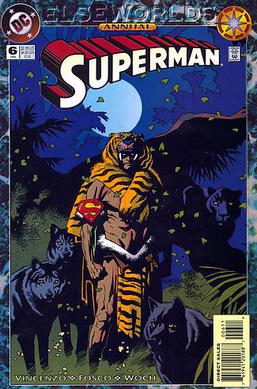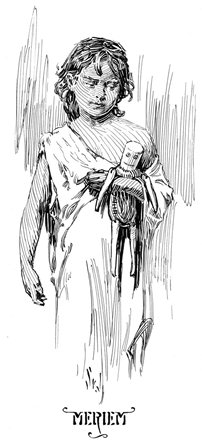
Mowgli is a fictional character and the protagonist of the Mowgli stories featured among Rudyard Kipling's The Jungle Book stories. He is a feral boy from the Pench area in Seoni, Madhya Pradesh, India, who originally appeared in Kipling's short story "In the Rukh" and then became the most prominent character in the collections The Jungle Book and The Second Jungle Book (1894–1895), which also featured stories about other characters.

The Second Jungle Book is a sequel to The Jungle Book by Rudyard Kipling. First published in 1895, it features five stories about Mowgli and three unrelated stories, all but one set in India, most of which Kipling wrote while living in Vermont. All of the stories were previously published in magazines in 1894–5, often under different titles. The 1994 film The Jungle Book used it as a source.

The Big Bad Wolf is a fictional wolf appearing in several cautionary tales, including some of Grimms' Fairy Tales. Versions of this character have appeared in numerous works, and it has become a generic archetype of a menacing predatory antagonist.

Bagheera is a fictional character in Rudyard Kipling's Mowgli stories in The Jungle Book and The Second Jungle Book. He is a black panther who serves as friend, protector and mentor to the "man-cub" Mowgli. The word bagheera is Hindi for panther or leopard, although the root word bagh means any form of panthera and is nowadays mostly used to refer to the Royal Bengal tiger.

Shere Khan is a fictional Bengal tiger in Rudyard Kipling's Jungle Book and its adaptations, in which he is often portrayed as the main antagonist. The name roughly translates as tiger ruler, with shere being the Persian word for 'tiger'(but used in north India to refer to lions), and khan being used as a title of distinction among the Turco-Mongol peoples, usually meaning chief or ruler. According to The Kipling Society, the name "show[s] that he is the chief among tigers".

Amala and Kamala were two "feral girls" from Midnapore, Bengal, India, who were alleged to have been raised by a wolf family.

Tarzanesque is a term created by Frenchman Francis Lacassin used to describe characters in comic books inspired by Tarzan. A tarzanesque character resembles Tarzan in his physical resourcefulness, within a line of action that includes an adventurous life in the jungle, the gift of understanding and being understood by animals, contact with lost civilizations and courage combined with the ability to deal with nature. The creation of such characters may have been propitiated by the success that Tarzan had achieved since his appearance in literature in 1912, culminating with the release of daily comic strips in 1929, which paved the way for a genre that combined the allure of the unknown environment, the need for the archetypal characteristics of the hero and the popularity of access.

Jane Porter is a fictional character in Edgar Rice Burroughs's series of Tarzan novels and in adaptations of the saga to other media, particularly film. Jane, an American from Baltimore, Maryland, is the daughter of professor Archimedes Q. Porter. She becomes the love interest, later the wife of Tarzan and subsequently the mother of their son, Korak. She develops over the course of the series from a conventional damsel in distress, who must be rescued from various perils, to an educated, competent and capable adventuress in her own right, fully capable of defending herself and surviving on her own in the jungles of Africa.

A jungle girl is an archetype or stock character, often used in popular fiction, of a female adventurer, superhero or even a damsel in distress living in a jungle or rainforest setting. A prehistoric depiction is a cave girl.

The Jungle Book is an Italian-Japanese anime adaptation of Rudyard Kipling's original collection of stories, The Jungle Book. It aired in 1989, and consists of a total of 52 episodes.
Kala is a fictional ape character in Edgar Rice Burroughs's original Tarzan novel, Tarzan of the Apes, and in movies and other media based on it. She is the ape mother of Tarzan who raises him.

Superman: The Feral Man of Steel is a DC Comics Elseworlds special published in 1994, written by Darren Vincenzo, pencilled by Frank Fosco and inked by Stan Woch.

Akela is a fictional character in Rudyard Kipling's stories, The Jungle Book (1894) and The Second Jungle Book (1895). He is the leader of the Seeonee pack of Indian wolves and presides over the pack's council meetings. It is at such a meeting that the pack adopts the lost child Mowgli and Akela becomes one of Mowgli's mentors.

The Jungle Book: Mowgli's Story is a 1998 American adventure film directed by Nick Marck, produced by Mark H. Orvitz and written by José Rivera and Jim Herzfeld. It is the third film adaptation by The Walt Disney Company of the Mowgli stories from The Jungle Book (1894) by Rudyard Kipling. It stars Brandon Baker, and features the voice work of Brian Doyle-Murray, Eartha Kitt, Clancy Brown, Peri Gilpin, and Sherman Howard.

Meriem is a character in Edgar Rice Burroughs's series of Tarzan novels, and the heroine of the fourth, The Son of Tarzan.

A feral child is a young individual who has lived isolated from human contact from a very young age, with little or no experience of human care, social behavior, or language. Such children lack the basics of primary and secondary socialization. The term is used to refer to children who have suffered severe abuse or trauma before being abandoned or running away. They are sometimes the subjects of folklore and legends, often portrayed as having been raised by animals. While there are many cases of children being found in proximity to wild animals, there are no eyewitness accounts of animals feeding human children.

Tarzan is a fictional character, a feral child raised in the African jungle by the Mangani great apes; he later experiences civilization, only to reject it and return to the wild as a heroic adventurer.
Tublat is a fictional ape character in Edgar Rice Burroughs's original Tarzan novel, Tarzan of the Apes and one of its sequels, Jungle Tales of Tarzan, as well as animated films, television series and other media based on them.














